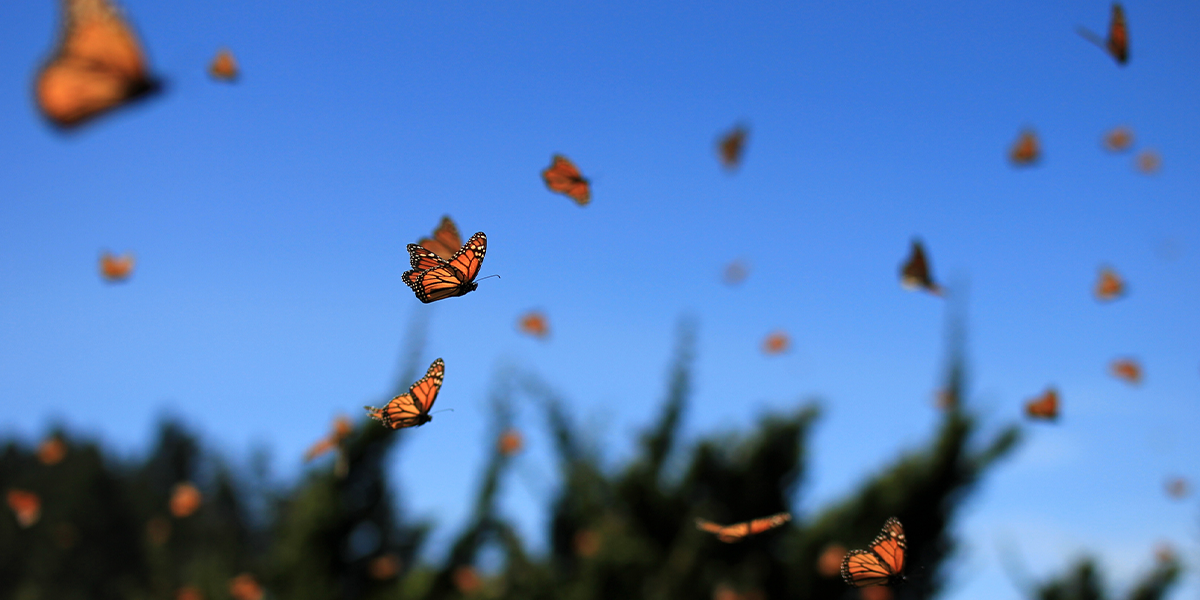
Roadsides possess a certain beauty with their drifts of foxtail barley, yellow splashes of sunflower, and patches of milkweed and flittering monarch butterflies. This final pairing makes these narrow strips of vegetation seem like excellent spaces for monarch conservation. Plant more milkweed along roads; feed more butterflies. “There are millions of acres of roadside, so there's a lot of potential,” says Emilie Snell-Rood, a professor in the Department of Ecology, Evolution and Behavior.
Yet roadside habitats are controversial. Some conservationists worry the conditions are too dangerous for monarchs, suggesting that threats posed by high-speed vehicles and toxins outweigh the benefits. Recently, however, Snell-Rood worked with colleagues to rule out at least one of these threats: high concentrations of road salts from winter ice control.
“We measured as many traits as possible, and overall, there was no negative effect of increased salt,” says Snell-Rood, whose findings were recently published in Conservation Science and Practice. She had previously investigated the impact of salt on monarchs in laboratory settings, finding that certain salt concentrations could actually have positive effects on monarch health. Still, she wanted to understand how these dynamics would pan out in the real world, especially during the daunting migration monarchs undertake each fall.
Monarchs follow a remarkable migration pattern. They leave Mexico in the spring, and after three to four generations of incremental migration to points across eastern North America during the summer months, the final generation emerges from their chrysalids in the late summer, ready to reverse course to their overwintering grounds in Mexico. This means monarchs from Minnesota must undertake an epic 1,800-mile migration. Snell-Rood wanted to determine if road salts would impact whether the monarchs could survive this journey.
The researchers timed their study to coincide with the fall migration in 2019, raising approximately 2,700 monarch caterpillars in outdoor tents and feeding them milkweed sprayed with three concentrations of salt to replicate different roadside conditions. When the adult butterflies eventually emerged, the team photographed each one and tested them for a common parasite. They then tagged the monarchs as part of the Monarch Watch program before releasing them to join their migratory kin. “It was challenging,” Snell-Rood says, noting that some days hundreds of butterflies would emerge at once and have to be processed. “We had whole teams of people that would go out to help.”
Normally, only a small percentage of the monarchs tagged in the Midwest are observed in their overwintering grounds in Mexico, and the 2019 migration bore even lower numbers than usual. In the end, however, collaborators recovered seven individuals from the experiment, with at least two butterflies representing each of the three salt treatments. Based on analyses of these butterflies, including the amount of sodium concentrated in their bodies, the researchers determined that the simulated roadside habitats had no negative impact on migratory success.
Back at the lab, Snell-Rood’s team also analyzed the photographs and measurements taken for all 2,700 butterflies prior to migration, testing for effects of salt on body size, development time, and parasitic infections. The team also kept about 250 monarchs for more detailed analyses, observing whether the sodium treatments caused differences in wing coloration, immune system health, and fat stores. Across all of these tests, they found no detrimental effects.
“Overall, it suggests that at least with respect to the toxicity of road salt in roadside habitat, we shouldn't be that worried for monarchs,” Snell-Rood explains, noting that her lab is now investigating threats posed by tire microplastics and heavy metals. There’s also a need for additional research on whether roadside habitats increase the risk of monarchs being hit by vehicles. For now, however, the emerging trends make the roadside tableau with monarchs and milkweed seem a bit more promising. –Jonathan Damery